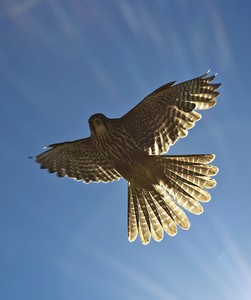For those who have no fucking clue what the difference is between a regular skydiving suit and a camera suit, welcome to the club. I'd not known there was a difference either.


Normal suits, like those on the right, ain't got wings. Camera suits, on the other hand, do. Well, flaps, anyway. And those itsy-bitsy wings have a measurable effect. The terminal velocity of a skydiver is roughly 124 mph. But the Mythbusters measured the terminal velocity of a skydiver in a camera suit as 114 mph. What good is a 10 mph difference? Well, it opens up some additional options:
If you plan on spending a great deal of time in the air, you should consider a skydiving suit called a camera suit. This kind of suit has an added feature: wings that give you more control to slow down your descent when desired. This is especially desirable if you decide to strap a camera on your helmet for videotaping the experience, since you can slow down and pan when you want to.That makes skydiving in a camera suit a rather dramatic demonstration of the principles of evolution in action. Think of flying. The most usual objection raised is, "What good is half a wing?" Camera suits don't even include half a wing. It's a pathetic little flap that looks totally useless. Yet it conveys greater control over airspeed. And when you're falling out of a plane trying to film other people falling out of planes, that's a critical advantage. Extrapolate that to falling out of trees, and you can get a better understanding of the incremental change that can lead from skin flap to full wing and powered flight.
Richard Dawkins puts it this way in Climbing Mount Improbable:
The way to think of the gradual evolution of a flying squirrel is this. To begin with, an ancestor like an ordinary squirrel, living up trees but without any special gliding membrane, leaps across short gaps. However far it can leap without the aid of any special flaps of skin, it could leap a few inches further - and hence save its life when it encounters a gap of critical distance - if it had a very slight flap of skin, or a very slightly increased bushiness of the tail. So natural selection favours individuals with slightly pouchy skin around the arm or leg joints, and this becomes the norm. The normal leaping distance of an average member of the population has thereby been increased by a few inches. Now, any individuals with an even larger skin web can leap a few inches further. So in later generations this extension of skin becomes the norm. For any given size of membrane, there exists a critical gap such that a marginal increase in the membrane makes all the difference between life and death.And what the fuck do flying squirrels have to do with birds, you ask? Excellent question. Meet Microraptor:
Some scientists believe that bird flight evolved when ground-dwelling dinosaurs began to take to the skies. In contrast to this ‘ground-up’ theory, the ‘trees-down’ camp believes that tree-dwelling dinosaurs evolved flight to glide from tree to tree.You can easily imagine the gradual progression. Dinosaur feathers evolved to keep the little buggers warm. Some of the little buggers hung about in trees. The little buggers who hung about in trees and developed feathered skin flaps were better gliders, meaning better hunters and escape artists. And so it goes, generation by generation, until you end up with something like this guy:
And this is exactly what Microraptor did. It lacked the muscles for a ground take-off and couldn’t get a running start for fear of damaging its leg feathers. But a computer simulation showed that Microraptor could successfully fly between treetops, covering over forty metres in an undulating glide.
It is unclear if Microraptor could truly fly or was just an exceptional glider. Certainly, its body plan shows many features that would make its avian descendants such great aeronauts. It had a large sternum for attaching powerful flight muscles and strengthened ribs to withstand the heavy pressures of a flight stroke.
Its long, feathered tail acted a stabiliser and rudder and its tibia (shin bone) was covered in smaller, backwards-facing feathers. Modern birds of prey carry similar feather ‘trousers’ and Chatterjee believes that they helped to reduce drag by breaking up turbulent airflow behind the animal’s leg.
It could be that Microraptor’s biplane design was just a failed evolutionary experiment. But Chatterjee thinks otherwise. He believes that the biplane model was a stepping stone to the two-wing flight of modern birds. As the front pair of wings grew larger and produced more lift, they eventually took over the responsibilities formerly shared with the hind pair.

Pretty awesome, innit?
So we've gone from camera suits to squirrels to dinosaurs to falcons. Bet you never thought skydiving could demonstrate the principles of evolution so well (aside from in the strict Darwin Award sense, o' course). Were I a science teacher, I'd be taking definite advantage of that. Talk about your sense of wonder!
Tip o' the shot glass to the Discovery Channel for airing both The Dinosaur Feather Mystery and Mythbusters. They haven't got clips of Grant and Tory's adventures with camera suits up yet, but they've been kind enough not to have YouTube pull down the vids from their documentary on dinosaur feathers. Catch Microraptor on the wing at the 5 minute mark:







No comments:
Post a Comment